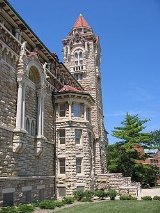
University of Kansas Natural History Museum
Encyclopedia
The University of Kansas
Natural History Museum is part of the University of Kansas Natural History Museum and Biodiversity
Research Center, which is itself part of the KU Biodiversity Institute.
The museum's galleries are in Dyche Hall on the university's main campus in Lawrence, Kansas
. The galleries are open from 9 a.m. to 5 p.m. Tuesday through Saturday and noon to 5 p.m. on Sundays. Dyche Hall has been listed on the National Register of Historic Places
since July 14, 1974; it was listed for its connection with Lewis Lindsay Dyche
and for its distinctive Romanesque
style of architecture.
The museum has developed some groundbreaking programs in the area of collection management and biodiversity informatics
, which uses collections data for forecasting environmental phenomena. The museum has a 3D scanner and has used it to create 3D image scans of its invertebrate fossil collection. In 2006 and 2007, the museum's insect researchers and collection, along with its collection of bird skeletons and parts of its extensive mammal collection, were moved to a new facility on the university's West Campus. Among the collection's more unique and interesting specimens are several "jackalopes" (rabbits with Shope's papillomavirus disease), and Comanche (horse)
, a survivor of the Battle of the Little Bighorn
.
University of Kansas
The University of Kansas is a public research university and the largest university in the state of Kansas. KU campuses are located in Lawrence, Wichita, Overland Park, and Kansas City, Kansas with the main campus being located in Lawrence on Mount Oread, the highest point in Lawrence. The...
Natural History Museum is part of the University of Kansas Natural History Museum and Biodiversity
Biodiversity
Biodiversity is the degree of variation of life forms within a given ecosystem, biome, or an entire planet. Biodiversity is a measure of the health of ecosystems. Biodiversity is in part a function of climate. In terrestrial habitats, tropical regions are typically rich whereas polar regions...
Research Center, which is itself part of the KU Biodiversity Institute.
The museum's galleries are in Dyche Hall on the university's main campus in Lawrence, Kansas
Lawrence, Kansas
Lawrence is the sixth largest city in the U.S. State of Kansas and the county seat of Douglas County. Located in northeastern Kansas, Lawrence is the anchor city of the Lawrence, Kansas, Metropolitan Statistical Area, which encompasses all of Douglas County...
. The galleries are open from 9 a.m. to 5 p.m. Tuesday through Saturday and noon to 5 p.m. on Sundays. Dyche Hall has been listed on the National Register of Historic Places
National Register of Historic Places
The National Register of Historic Places is the United States government's official list of districts, sites, buildings, structures, and objects deemed worthy of preservation...
since July 14, 1974; it was listed for its connection with Lewis Lindsay Dyche
Lewis Lindsay Dyche
Lewis Lindsay Dyche was a notable naturalist and also the creator of the Panorama of North American Plants and Animals, which was featured in the Kansas Pavilion at the 1893 World's Columbian Exposition. His taxidermy work is housed at The University of Kansas' Natural History Museum in Lawrence,...
and for its distinctive Romanesque
Romanesque architecture
Romanesque architecture is an architectural style of Medieval Europe characterised by semi-circular arches. There is no consensus for the beginning date of the Romanesque architecture, with proposals ranging from the 6th to the 10th century. It developed in the 12th century into the Gothic style,...
style of architecture.
The museum has developed some groundbreaking programs in the area of collection management and biodiversity informatics
Biodiversity Informatics
Biodiversity Informatics is the application of informatics techniques to biodiversity information for improved management, presentation, discovery, exploration and analysis...
, which uses collections data for forecasting environmental phenomena. The museum has a 3D scanner and has used it to create 3D image scans of its invertebrate fossil collection. In 2006 and 2007, the museum's insect researchers and collection, along with its collection of bird skeletons and parts of its extensive mammal collection, were moved to a new facility on the university's West Campus. Among the collection's more unique and interesting specimens are several "jackalopes" (rabbits with Shope's papillomavirus disease), and Comanche (horse)
Comanche (horse)
Comanche was a mixed Mustang/Morgan horse who survived General George Armstrong Custer's detachment of the United States 7th Cavalry at the Battle of the Little Bighorn.-Biography:...
, a survivor of the Battle of the Little Bighorn
Battle of the Little Bighorn
The Battle of the Little Bighorn, also known as Custer's Last Stand and, by the Indians involved, as the Battle of the Greasy Grass, was an armed engagement between combined forces of Lakota, Northern Cheyenne and Arapaho people against the 7th Cavalry Regiment of the United States Army...
.
See also
- Camarasaurus
- Entomology
- Glass Frog
- PresbyornisPresbyornisPresbyornis is an extinct genus of anseriform bird. It contains two unequivocally accepted species; the well-known P. pervetus and the much lesser-known P. isoni. P. pervetus was approximately the size and shape of a goose, but with longer legs; P. isoni, known from a few bones, was much larger,...
- Charles Duncan MichenerCharles Duncan MichenerCharles Duncan Michener is an American entomologist born in Pasadena, CA.-Biography:Much of his career has been devoted to the systematics and natural history of bees. His first peer-reviewed publication was in 1934, at the age of 16. He received his B.S. in 1939 and his Ph.D. in Entomology in...
- Michael S. EngelMichael S. EngelMichael S. Engel is an American paleontologist and entomologist. He has undertaken field work in Central Asia, Asia Minor, and the Western Hemisphere, and published more than 300 papers in scientific journals. He was trained at the University of Kansas where in 1993 he received a B.S. in Cellular...
External links
- Environmental Studies Program (ESP) - Related resources
- University of Kansas Natural History Museum Website

